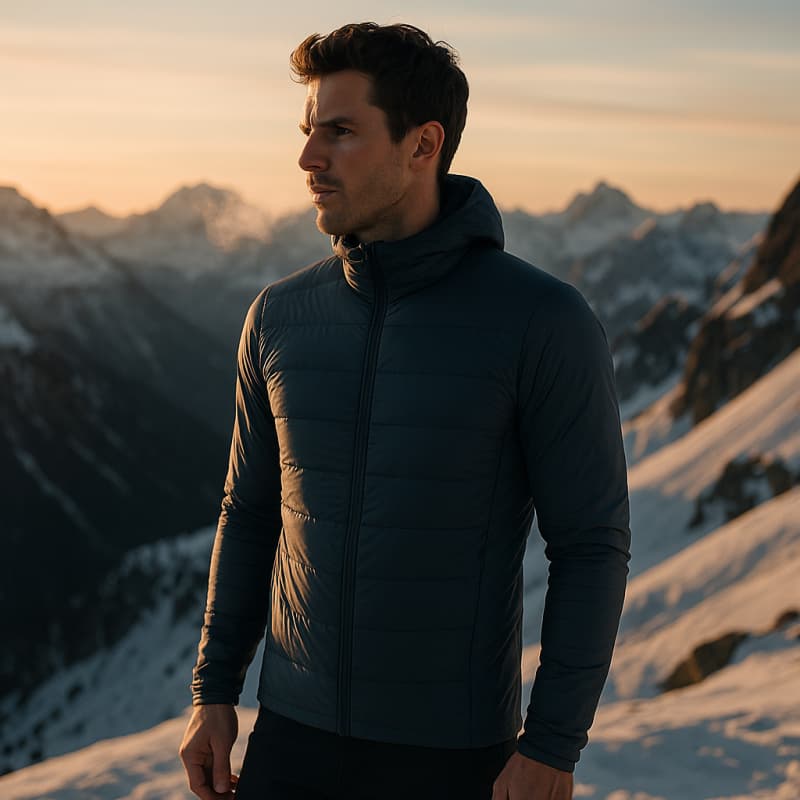You’ve probably stood in an outdoor gear store, holding two jackets that look almost identical, trying to figure out which one will actually keep you warm on that mountain trail or during your winter commute. One tag says “premium down“, the other mentions “aerogel fiber technology“. Aerogels are cheaper, but what about their performance? That’s where things get interesting. Choosing between aerogel fiber and down insulation isn’t just about warmth anymore—it’s about understanding how modern textile science is rewriting the rules of cold-weather protection.
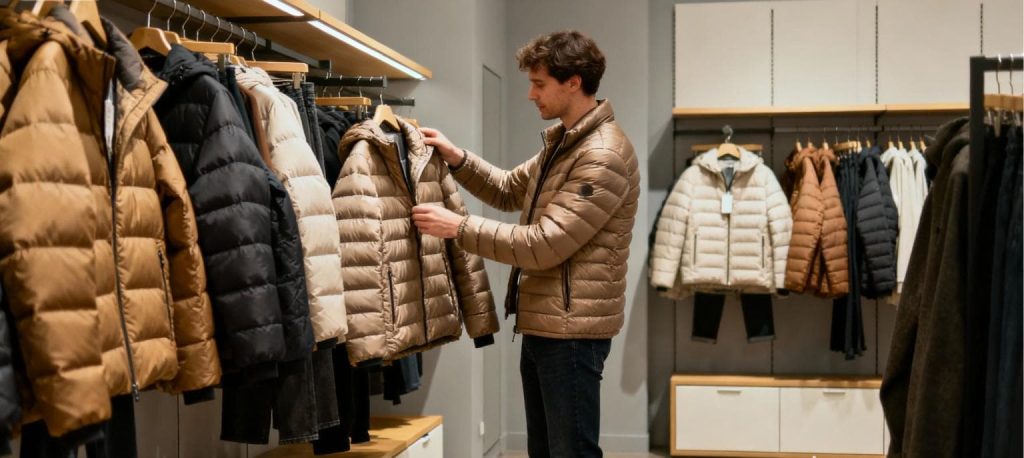
Down insulation has been the gold standard for decades, trusted by everyone from Arctic explorers to urban commuters. But aerogel fiber technology is challenging that dominance with some impressive claims: better thermal performance, lighter weight, much cheaper and reliability in conditions where down simply fails. Let’s break down what really matters when you’re deciding which insulation deserves a place in your winter wardrobe.
- Quick Comparison: Aerogel Fiber vs Down Insulation at a Glance
- What is Down Insulation? Understanding Traditional Fill Power
- What is Aerogel Fiber Insulation?
- Thermal Performance Comparison: Warmth-to-Weight Ratio
- Weight and Packability: Which is Lighter?
- Wet Weather Performance: The Critical Difference
- Durability and Longevity: Long-Term Performance
- Best Use Cases: When to Choose Each Material
- The Verdict: Which Insulation Should You Choose?
Quick Comparison: Aerogel Fiber vs Down Insulation at a Glance
Before we dive deep into the science and real-world testing, here’s what you need to know about how these two insulation technologies stack up against each other:
| Feature | Aerogel Fiber | Down Insulation | Winner |
|---|---|---|---|
| Thermal Conductivity | 0.017-0.020 W/m·K | 0.025-0.030 W/m·K | 🏆 Aerogel |
| Weight (Density) | 0.003 g/cm³ | 0.008-0.010 g/cm³ | 🏆 Aerogel |
| Wet Performance | Maintains 95% warmth | Loses 80% warmth | 🏆 Aerogel |
| Durability (50 washes) | 95% performance retained | 70-80% loft retained | 🏆 Aerogel |
| Breathability | Excellent | Normal | 🏆 Aerogel |
| Price Range | $$ | $$$$ | 🏆 Aerogel |
| Ethical Concerns | None | Animal welfare | 🏆 Aerogel |
| Best For | Wet conditions, active use, daily use | Dry cold, static warmth | – |
The numbers tell part of the story, but understanding what they mean for your actual experience in cold weather is where this comparison gets useful. Aerogel fiber wins on most technical metrics, but down still holds advantages in specific situations that matter to certain users.
What is Down Insulation? Understanding Traditional Fill Power
Down insulation consists of the soft, fluffy undercoating found beneath the feathers of ducks and geese. Unlike regular feathers with their stiff quills, down clusters create thousands of tiny air pockets that trap body heat while remaining remarkably lightweight. Think of it as nature’s version of bubble wrap, except each bubble is microscopic and the whole structure weighs almost nothing.

The magic of down happens in its three-dimensional structure. Each down cluster contains thousands of filaments that interlock and trap still air—and still air is what actually insulates you. The larger and more mature the bird, the larger the down clusters and the better the insulation. This is why goose down typically outperforms duck down: geese are bigger birds with larger, more effective down clusters.
When you see “fill power” ratings on down jackets, you’re looking at a measurement of how much space one ounce of down occupies in cubic inches. A 700 fill power down means one ounce expands to fill 700 cubic inches. Higher fill power translates directly to more warmth with less weight, which is why expedition-grade jackets often feature 850 or even 900 fill power down. But here’s the catch: higher fill power also means a higher price tag, and it comes with some serious performance limitations that become obvious the moment conditions get damp.
Down has dominated the insulation market for good reason—it’s incredibly warm for its weight, compresses beautifully for packing, and when properly cared for, can last over a decade. But anyone who’s ever worn a down jacket in rain or worked up a sweat during a winter hike knows its Achilles heel: moisture absolutely destroys down’s insulating ability.
What is Aerogel Fiber Insulation?
Aerogel fiber represents a completely different approach to staying warm. Instead of relying on natural materials, this technology uses nanoporous silica aerogel—the same material NASA developed for spacecraft insulation—encapsulated within flexible polyester fibers. The result is an insulation material that contains over 90% still air, just like down, but with a structure that doesn’t collapse when wet and provides even better thermal resistance.
The science behind aerogel fiber sounds complex, but the concept is straightforward. Aerogel itself is sometimes called “frozen smoke” because it’s mostly air held in place by an incredibly fine silica structure. Each fiber contains billions of nanoscale pores that trap air more efficiently than any natural material. This structure gives aerogel fiber a thermal conductivity of just 0.017-0.020 W/m·K, which is actually lower than still air itself at 0.026 W/m·K. That’s not a typo—aerogel fiber insulates better than air alone.

ShowarmX® aerogel fiber takes this technology and makes it practical for clothing. The aerogel particles are integrated into flexible fibers that can be woven or layered into fabrics without the brittleness you’d expect from a material originally designed for aerospace applications. You get the thermal performance of space-age insulation in a jacket that moves and feels like any other high-performance winter gear.
What makes aerogel fiber particularly interesting for winter clothing is how it maintains performance across different conditions. While down’s effectiveness depends heavily on staying dry and maintaining loft, aerogel fiber’s nanoporous structure works consistently whether you’re standing still in dry cold or working hard in wet snow. The hydrophobic nature of the silica means water doesn’t penetrate the insulation structure, so you don’t experience that sudden loss of warmth that happens when down gets damp.
Thermal Performance Comparison: Warmth-to-Weight Ratio
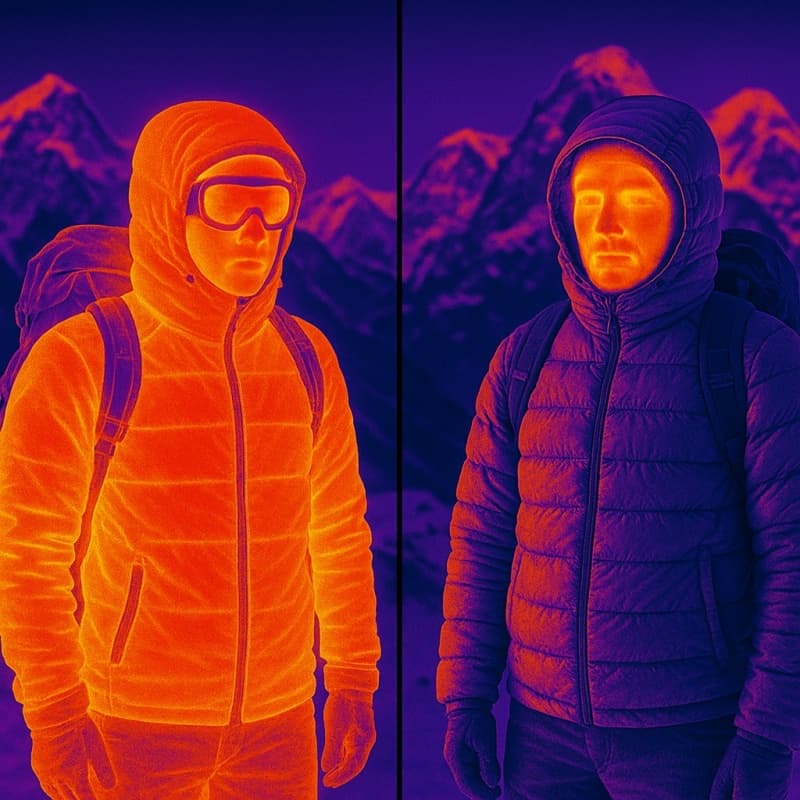
Here’s where the rubber meets the road: which insulation actually keeps you warmer? Independent testing according to ASTM C518 standards shows aerogel fiber with thermal conductivity between 0.017-0.020 W/m·K, compared to 700 fill power down at 0.025-0.030 W/m·K. Lower numbers mean better insulation, so aerogel fiber provides roughly 25-40% better thermal resistance per millimeter of thickness.
But thermal conductivity numbers don’t tell you everything about real-world warmth. Down creates more loft—that puffy appearance you associate with winter jackets—which means it traps more total air volume. For someone standing still in extreme cold, that extra loft can feel warmer even if the material itself is technically less efficient. This is why down remains popular for belay parkas and expedition sleeping bags where you’re not moving much.
The practical difference becomes clear when you compare equivalent garments. A jacket with 200 grams of aerogel fiber provides similar warmth to one with 280-300 grams of 700 fill power down. That’s a weight savings of 80-100 grams, which might not sound like much until you’re carrying that jacket in your pack for a week-long trip or wearing it during a full day of skiing. The lighter weight also means less bulk, so you get better freedom of movement without sacrificing warmth.
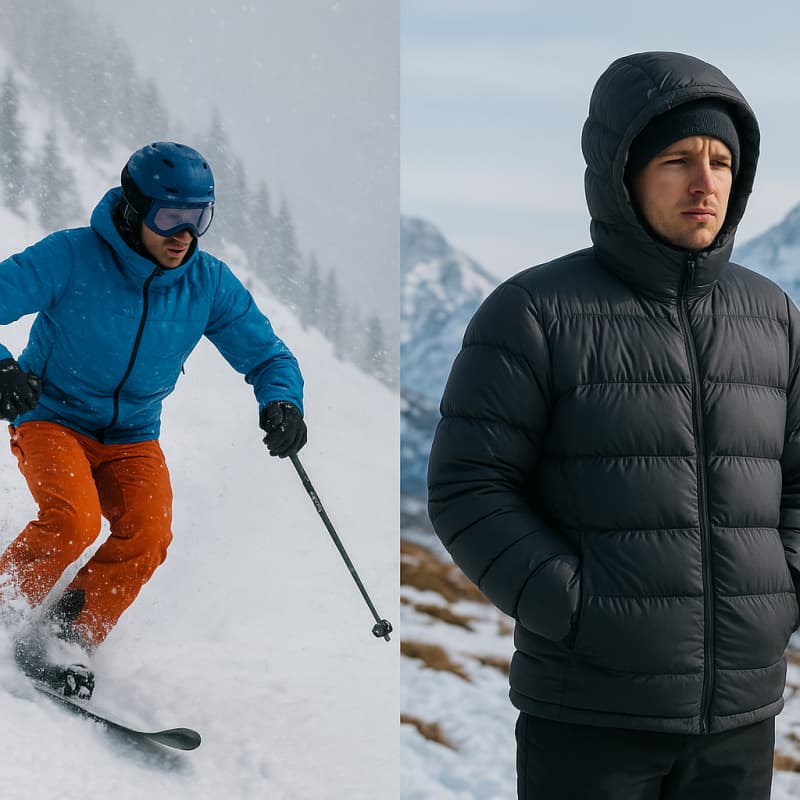
Temperature ratings help illustrate this difference. A 3mm layer of aerogel fiber insulation typically provides comfort down to -10°C and extreme protection to -25°C. To achieve the same ratings with down, you’d need about 25mm of 700 fill power down or 22mm of premium 800 fill power down. That’s a significant difference in jacket thickness, which affects everything from how the garment fits under a shell to how easily you can layer it with other pieces.
Weight and Packability: Which is Lighter?

Aerogel fiber wins the weight battle decisively. With a density of just 0.003 g/cm³ compared to down’s 0.008-0.010 g/cm³, aerogel fiber weighs roughly one-third as much as down for the same volume. Combined with its superior thermal efficiency, this means aerogel fiber jackets typically weigh 30-40% less than down equivalents providing the same warmth.
But packability is a different story. Down’s natural structure allows it to compress to incredibly small sizes and then spring back to full loft when unpacked. This compression recovery is where down still holds an advantage. If you’re an ultralight backpacker trying to fit a week’s worth of gear into a 40-liter pack, down’s ability to stuff into a tiny compression sack and then fully recover its insulating properties is genuinely valuable.
Aerogel fiber compresses reasonably well—you can pack an aerogel jacket into a stuff sack without issues—but it doesn’t achieve the same minimal packed size as high-quality down. The synthetic fiber structure has some memory, so it doesn’t compress quite as small, and it takes a bit longer to fully expand after being compressed for extended periods. For most users, this difference is negligible. For thru-hikers and alpinists where every cubic inch of pack space matters, it’s worth considering.
Storage is another consideration. Down requires careful storage to maintain loft—you should never leave down jackets compressed for long periods, as this permanently damages the down clusters and reduces insulating ability. Aerogel fiber is far more forgiving. You can stuff it in a closet, leave it compressed in your car, or pack it away for months without worrying about performance degradation. This maintenance-free aspect makes aerogel fiber more practical for casual users who don’t want to fuss over their gear.

Wet Weather Performance: The Critical Difference
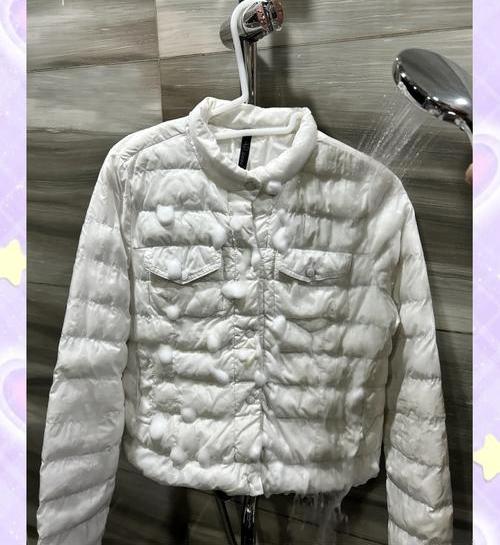
This is where aerogel fiber absolutely dominates, and it’s the single most important factor for most users. Down’s fatal flaw is moisture. When down gets wet, the clusters collapse and clump together, losing their ability to trap air. A down jacket that’s been soaked in rain or saturated with sweat can lose 70-80% of its insulating ability. You’re essentially wearing a cold, heavy, useless garment until it dries—and down takes forever to dry.
Anyone who’s experienced this knows how miserable it is. You’re on a mountain trail, working hard, and your body heat creates moisture inside your jacket. Or you get caught in unexpected rain. Suddenly your expensive down jacket isn’t keeping you warm anymore, and you’re facing a potentially dangerous situation. Down manufacturers have tried to address this with water-resistant treatments, but these only delay the inevitable. Once down is truly wet, it’s game over until you can dry it properly.
Aerogel fiber changes this equation completely. The nanoporous silica structure is inherently hydrophobic—water doesn’t penetrate the insulation. Even when the outer fabric gets wet or you’re sweating heavily during high-output activities, aerogel fiber maintains 90-95% of its thermal performance. The difference in drying time is equally dramatic. A soaked aerogel fiber jacket returns to full performance in 2-4 hours of air drying. A down jacket in the same conditions needs 24-36 hours, or 4-6 hours with a dryer and tennis balls to break up the clumps.
For anyone living in or traveling to wet climates—the Pacific Northwest, UK, Scandinavia, or anywhere with mixed precipitation—this performance difference is decisive. Aerogel fiber works reliably regardless of conditions. Down requires you to constantly monitor weather and manage moisture, and even then, you’re gambling that conditions won’t turn against you. The peace of mind that comes with knowing your insulation will work even if things get wet is worth a lot.
Durability and Longevity: Long-Term Performance
Down degrades over time, even with excellent care. Each wash cycle, each compression, each season of use gradually breaks down the delicate down clusters. After 50-100 wash cycles or 5-10 years of regular use, even premium down loses 20-30% of its original loft and insulating ability. You’ll notice your down jacket doesn’t feel as puffy or warm as it once did. This degradation is inevitable with natural materials.
Aerogel fiber’s synthetic structure is far more stable. Laboratory testing shows aerogel fiber retains 95% of its thermal performance after 50 wash cycles. The nanoporous silica structure doesn’t break down the way organic materials do, and the encapsulating polyester fibers are highly durable. Users report aerogel fiber jackets maintaining their performance for 15-20 years of regular use, significantly longer than down equivalents.
Washing is another durability consideration. Down requires special detergents, careful washing on gentle cycles, and meticulous drying with tennis balls to restore loft. Mess up the washing process, and you can permanently damage your down jacket. Aerogel fiber is virtually maintenance-free—toss it in a regular washing machine, use standard detergent, and hang it to dry. The insulation doesn’t clump, doesn’t require special treatment, and comes out performing just as well as before.
Best Use Cases: When to Choose Each Material
So which insulation should you actually buy? The answer depends on how you’ll use it. Aerogel fiber is the better choice for most people in most situations, but down still makes sense for specific applications.
Choose aerogel fiber if you face any wet or humid conditions, engage in active winter sports, or simply want reliable performance without fussing over maintenance. The superior moisture resistance makes aerogel fiber ideal for skiing, snowboarding, winter mountaineering, running, or cycling. If you live in maritime climates where rain and snow mix, or you tend to work up a sweat during winter activities, aerogel fiber eliminates the anxiety of wondering whether your insulation will fail when you need it most. The lighter weight and better warmth-to-weight ratio also make aerogel fiber excellent for winter travel, daily commuting, and any situation where you want maximum warmth with minimum bulk.


Down still has its place for ultralight backpackers who need absolute maximum packability and don’t mind the extra care requirements. If you’re planning expeditions in guaranteed dry, extreme cold—think Arctic travel or high-altitude mountaineering in winter—down’s natural loft provides exceptional static warmth when you’re not moving. Some users also simply prefer natural materials for philosophical or aesthetic reasons, and if you have proper storage facilities and enjoy the ritual of maintaining your gear, down can be a satisfying choice.
Many experienced outdoor enthusiasts use both strategically. An aerogel fiber jacket for active use and wet conditions, paired with a down piece for static warmth at camp or during rest stops, gives you the best of both worlds. This layering approach lets you optimize for different activity levels and conditions without compromising.
The Verdict: Which Insulation Should You Choose?
After comparing thermal performance, weight, moisture resistance, durability, and real-world applications, aerogel fiber emerges as the superior choice for most winter clothing needs. The combination of better insulation per gram, reliable wet-weather performance, lighter weight, and maintenance-free durability makes aerogel fiber the smarter investment for anyone who wants gear that simply works without constant attention.
Down remains relevant for specialized applications where maximum packability outweighs all other concerns, or for users in consistently dry, extreme cold who prioritize natural materials. But for the vast majority of winter clothing applications—from ski jackets to thermal underwear, from mountaineering shells to urban winter coats—aerogel fiber technology delivers better performance with fewer compromises.
The textile industry is moving toward advanced synthetic insulations like aerogel fiber as manufacturing costs decrease and performance advantages become undeniable. Major outdoor brands are increasingly adopting these technologies, and as more users experience the difference, the shift away from down for high-performance applications will likely accelerate. Aerogel fiber represents where winter insulation is headed: cheaper, lighter, warmer, more reliable, and free from the limitations that have always held down back.
Discover our aerogel thermal insulation Yarn
View More →


